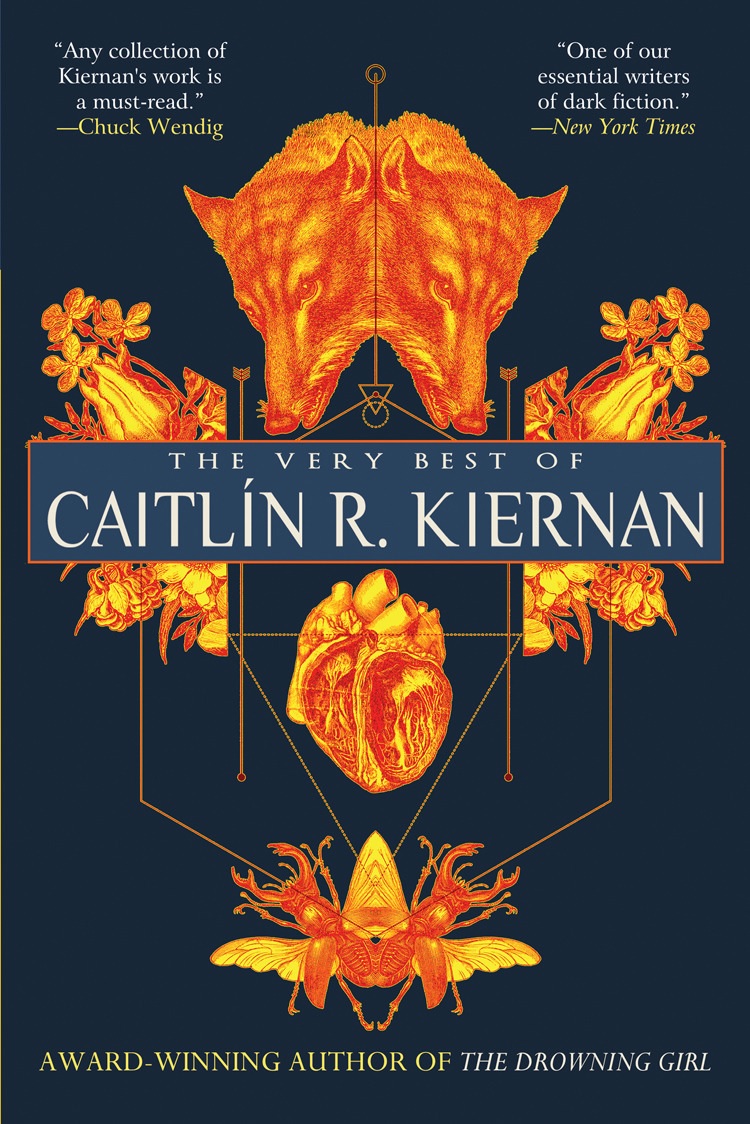A review of The Very Best of Caitlín R. Kiernan

With a writer like Caitlín R. Kiernan, a title like The Very Best of… is begging a lot. Where’s the ferociously parodic, deconstructive urban fantasy she writes under her Kathleen Tierney nom de guerre? Where’s the Delta Green-flavoured Lovecraftian technothrillers like Agents of Dreamland and Black Helicopters? Where’s her comic contribution to the Sandman mythos? In any collection from such an author, there’s always bound to be, not only favourite stories, but entire sub-genres missed out. I want to put in this quote to illustrate the point, because it’s the kind of thing you so rarely get to include in a review: “Brown University’s John Hay Library has established the Caitlín R. Kiernan Papers, spanning her full career thus far and including juvenilia, consisting of twenty-three linear feet of manuscript materials, including correspondence, journals, manuscripts, and publications, circa 1970-2017, in print, electronic, and web-based formats.” Count ‘em: twenty-three linear feet. It’s a brave editor or publisher who would dare try to encapsulate every facet of an author so various, and so prolific.
What this compilation does demonstrate is that Caitlín R. Kiernan is producing the very best of contemporary dark and weird fiction, regardless of whether or not that typifies her whole range. She not only has written more than nine-tenths of her contemporaries, she has also written substantially better than nine-tenths of them. She casually throws off metaphor and imagery in passing that would make any other writer’s career. Kiernan has a word horde as rich as Smaug’s, and a voice as mesmeric.
Part of her mastery of different genres and sub-genres is her unerring ear for the idioms, idiolects, speech communities, buzzwords, shibboleths, jargon, psychobabble, technobabble, Mythobabble of each side alley and cul-de-sac of imaginative literature. Her debt to 1890s decadent literature might have helped tune her ear for distinct prosodies, but even when it’s fully on view, as in “La Peau Verte,” it isn’t anything like as overblown and cloying as Angela Carter or Poppy Z. Brite. Kiernan’s frame of stylistic reference isn’t anything like that narrow, and she doesn’t wallow in overwrought prose like many self-declared decadent authors. She tosses in quotations and references from the whole gamut of literature that you’d ache to see more often in genre fiction, yet she keeps a sinew and thrust in her writing that nails all the glitter and sparkle of her stylistic brilliance firmly to the underlying contours of her narrative. Sometimes her more experimental pieces do tax the reader’s patience – I’m no fan of the unparagraphed construction of “Interstate Love Song (Murder Ballad No. 8)” for instance – but such excesses are rare, and generally tempered by a propulsive impetus, let alone a turn of phrase, that makes her fables unputdownable. “Houses under the Sea,” does dip into the deep waters of her best-known single work, The Drowning Girl: A Memoir, but that doesn’t render this collection any less a partial glimpse at best. And there’s that word again.
Kiernan has gone on record in the past to state that she’s “getting tired of telling people that I’m not a ‘horror’ writer. I’m getting tired of them not listening, or not believing.” It’s true that miscegenation and body horror are recurrent themes – steampunk prostheses, flesh sculptures, alien distortion/transcendence of normal humanity – frequently embodied in or espoused by mutated former lovers. Yet she typifies horror as “an emotion, and no one emotion will ever characterize my fiction.” She’s also said that “story bores me. Which is why critics complain it’s the weakest aspect of my work.” I don’t see any lack of story in these stories, though. I also suspect that Kiernan wouldn’t have been able to keep readers’ attention across such a huge volume of work unless she was able to keep them engaged through extended narratives with more than just jewelled individual sentences. She shares that characteristic gift of a really good short story writer of tieing off a section or a passage with a line that hooks you and leaves you gasping, aching to see what comes next. And if she has any uniformity of tonal range or register, it’s one that carries superbly well across genre after genre, from the folk horror of “A Child’s Guide to the Hollow Hills,” to the superb occult noir of “The Maltese Unicorn.” Not only would what she pulls off in that one story alone make another writer’s entire career, I’ve actually seen it happen.
In their introduction to The Weird, Ann and Jeff VanderMeer write that Kiernan has “become perhaps the best weird writer of her generation.” There’s only two parts to that statement I’d question: Only weird? And perhaps? Weird fiction as a genre, if it is a genre, should be grateful to be able to lay even partial or intermittent claim to her. Caitlín R. Kiernan is the fulfilment of every weird fiction pundit’s dream of a transgressive, inclusive, brutally contemporary author who brings all the territory’s sub-genres bang up to date while ditching their historical baggage – yet she effortlessly transcends such categories and limitations, just as she effortlessly transcends every genre she’s cared to touch down in. Even after successive World Fantasy Awards and Bram Stoker Awards, she’s still a writer who can’t be honoured and recognized enough. Words fail me. But they rarely if ever fail her.
